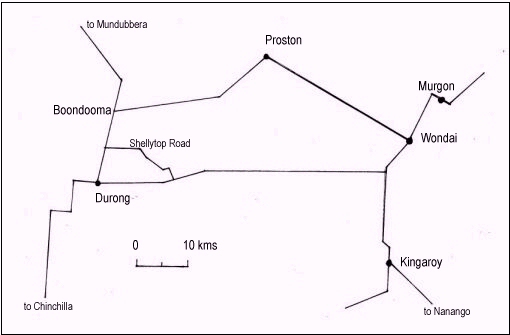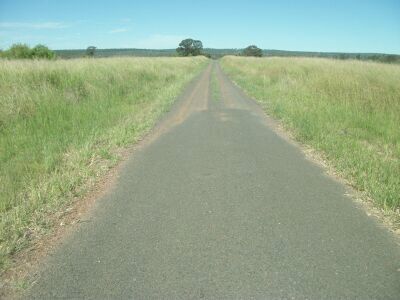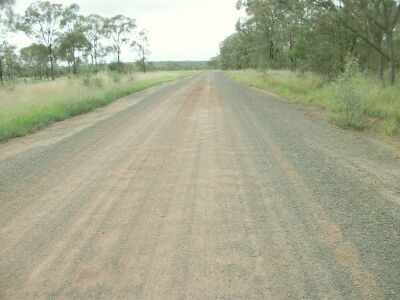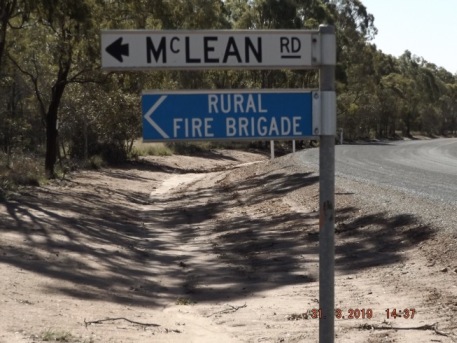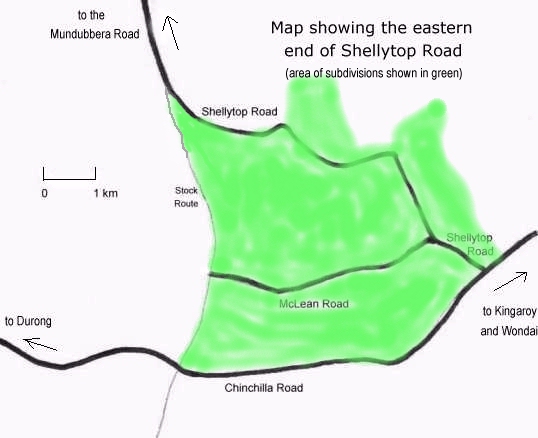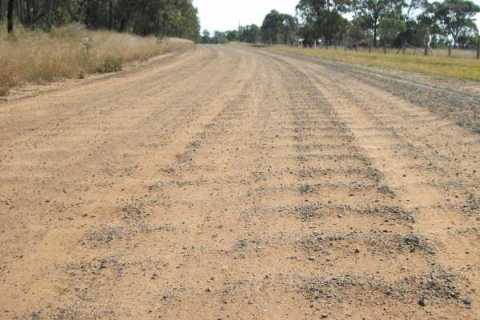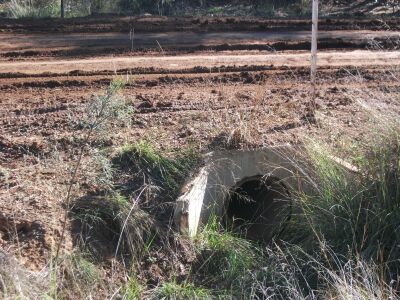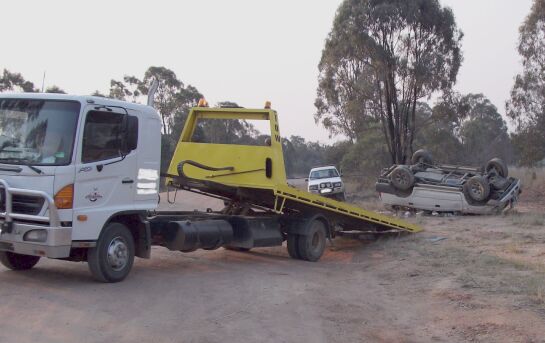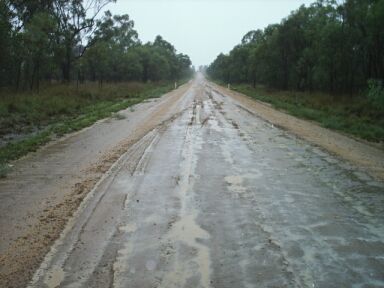Dealings of South Burnett Regional Council (SBRC)
Roads
Last updated: 6th November 2019
This report describes SBRC's preferential dealing in relation to roads.
Click to select, or scroll down the page:-
SBRC's Black Strategies - Roads
Analysis of SBRC's black strategies
has led to new insights into many of SBRC's activities,
including road maintenance.
One of the reasons why SBRC gives a low priority to roads
in the rural residential subdivisions of SBRC's electoral Division Six
is because of SBRC's deeply-ingrained strategy of preferential dealing.
For example,
see
below
for information about how SBRC
obtained government grants to fix specific neglected rural gravel roads,
but preferentially transferred part of the benefit
to other roads of its own choosing.
Another reason for underfunding road maintenance
in the rural residential subdivisions
is that it helps to deter potential residents from buying land or
building properly-approved residences there.
SBRC does not want the electoral roll to become
cluttered with too many people who might not vote the right way.
See
SBRC's Black Strategy 3
for more information about SBRC's preferential dealing.
See
SBRC's Black Strategy 4
for more information about the various ways in which SBRC
hinders population growth in the region.
Shellytop Road - a Classic Case of Preferential Dealing
There are many gravel roads in the South Burnett,
many of which are candidates for upgrade to bitumen.
For example, one such road is Shellytop Road near Durong.
Location of Shellytop Road.
Bitumen for the Quiet End but Not for the Busy End
Several years ago, approximately one kilometre of the quiet western end of Shellytop Road
was upgraded to bitumen.
No good reason is known to kingaroar.com why
the much busier and more dangerous eastern end of Shellytop Road to this day still does not have bitumen.
Shellytop Road - quiet western end with bitumen, March 2012
Shellytop Road - busy eastern end with no bitumen, March 2012
The upper photo above shows the western end of Shellytop Road
where the bitumen ends and the dirt road begins.
The bitumen runs for a kilometre from the location of this photo
to where Shellytop Road joins the Mundubbera-Durong Road.
The grass growing in the middle of the dirt road indicates
that the road here is so little used
that it rarely even needs to be graded.
The narrowness of the road confirms that it is a rare event
for two vehicles to pass each other travelling in opposite directions.
In contrast, the lower photo above shows the eastern end of Shellytop Road
approximately one kilometre from where it joins the Chinchilla-Wondai Road.
The width of the road, the absence of vegetation in the
middle of the road and the tyremarks all indicate
that the non-bitumen eastern end of Shellytop Road is used
between ten and a hundred times more than the bitumenised western end.
There are two reasons why the eastern end of Shellytop Road
should have a high priority for upgrade.
Firstly, it is the route through which more than eighty properties
in Shellytop Road and McLean Road are accessed.
Secondly, the eastern end of Shellytop Road has
experienced several single-vehicle rollover accidents
and therefore if the road is not improved then it can
be predicted that fatal accidents are likely to occur there.
The western end of Shellytop Road has very little traffic.
The properties at the western end of Shellytop Road
are few in number and are quite large, typically thousands of acres.
Kingaroar.com is aware of only two residences that exist
within kilometres of the western end of Shellytop Road.
Only one residence is anywhere near the bitumen section of road.
Its gateway is approximately 200 metres from the section of bitumen.
The eastern end of Shellytop Road carries much more traffic
than the quiet western end.
Another reason why most traffic on Shellytop Road enters
and leaves the road at its eastern end
is because this is the end that is nearest to the regional centre of Kingaroy.
People with property in the eastern part of Shellytop Road seldom have any reason
to venture to the western end of the road in the direction of Mundubbera.
Preferential Transfer of Benefit
Update: 6th November 2019
SBRC expenditure
on roads in the 2018-19 year did not decrease,
despite large subsidies having been received by SBRC in grants
from the Queensland Government's "Works for Queensland" program
for works such as gravel resheeting of specific neglected gravel roads.
The subsidies were additional expenditure
on top of what SBRC would normally have spent.
The subsidies were for work on gravel roads.
Not many people have noticed, but the ratepayer-funded money
that would normally have been spent on these gravel roads was still spent,
but not on these roads.
Instead, the money must have been spent elsewhere on bitumen roads
in addition to the money that would normally have been spent on them.
If the money that would normally have been spent on the gravel roads
had been added to the grant money received for them,
then some of the busiest unsealed gravel roads
in the western rural residential subdivisions
could easily have been upgraded to bitumen.
In other words, SBRC obtained government grants
to fix specific neglected rural gravel roads,
but preferentially transferred part of the benefit
to other roads of its own choosing.
Gravel and Shoulder Resheeting
Update: 2nd April 2019
Gravel and Shoulder Resheeting of Shellytop Road.
Appears to have been entirely funded by Queensland Government grants.
If SBRC's grant applications had been rejected
then resheeting would not have happened.
Yet, rejection of grant applications would not
have reduced any expenditure on bitumen roads.
This is proof that SBRC gives the eastern end of Shellytop Road the lowest priority.
In late 2018, SBRC performed gravel resheeting
on several unsealed roads, including T H Burns Road.
In early 2019, SBRC performed a heavy formation grade and/or resheeting
on an additional ten unsealed roads throughout the South Burnett.
Some sections of Shellytop Road were resheeted in March 2019.
During the first quarter of 2019, SBRC also performed grading work
on eighty-eight other unsealed roads.
On 21st February 2019, SBRC-friendly news website southburnett.com.au
described the work:-
"The aggressive road maintenance schedule is tackling light to moderately trafficked
unsealed roads, and roads which have become badly degraded."
......
"As well, 10 regional roads with higher traffic volumes were scheduled to receive
a heavy formation grade and gravel resheeting by the end of February."
The southburnett.com.au report was not completely accurate
because only four of the ten "higher traffic volumes" roads received both
a heavy formation grade and a gravel resheet.
The other six higher traffic roads including sections of Shellytop Road
received either a resheet or a heavy formation grade, but not both.
This is confirmed in the minutes of the SBRC meeting of 20th March 2019.
Nevertheless, the southburnett.com.au report marks a milestone
because it was the first time ever,
as far as kingaroar is aware,
that any entity associated with SBRC
has admitted that Shellytop Road carries more traffic
than most other unsealed roads in the region.
On page 3 of the minutes of the SBRC meeting held on 25th June 2018
to rubber-stamp SBRC's 2018/19 budget,
Mayor Campbell described a $4.365 million grant to SBRC from the state government's
"Works for Queensland Program Round 2",
of which $2.245 million was carried forward into the 2018/19 year.
Mayor Campbell commented that the grant was unique because
it provided funding for maintenance work
that did not have to be matched by a contribution from council.
In December 2018, it was reported in the media that
under the Works for Queensland program
SBRC would receive an
additional $2.2 million in 2019 and a further similar amount again in 2020.
Adding the $2.245 million from the grants program carried forward from last year
to the additional $2.2 million received this year
gives a total of $4.445 million for 2018/19.
It does not appear to be just a coincidence
that the figure of $4.445 million is very similar to the $4.5 million figure
that Councillor Jones is reported
to have said is the cost of the gravel resheeting program for this year.
Councillor Jones is also reported to have stated
that this $4.5 million budget was boosted up from $1.5 million
"at no expense to the ratepayers".
In summary,
it appears that the current program of gravel resheeting work
on unsealed roads in the South Burnett
is wholly funded from Works for Queensland grants,
and does not involve any expenditure of money by SBRC.
"Works for Queensland" signs were erected on T H Burns Road in late 2018.
According to page 6 of the minutes of SBRC's budget meeting,
SBRC is spending $25.96 million on roads in 2018/19,
including the $4.445 million Works for Queensland grants from the state government.
It appears that SBRC had to submit a list of projects when applying for the grants.
This probably explains why Shellytop Road was included in the program
because, to justify funding for other less-deserving roads elsewhere in the South Burnett,
the "higher traffic volume" Shellytop Road with its chronically poor maintenance history
had to at least be included in the list, if not placed at the top of the list.
If Shellytop Road had not been included in SBRC's grant application list
then, in comparison, most of the other projects on the list would have had little merit.
Unsealed roads in the western region of the South Burnett
have always been given the lowest priority for expenditure by SBRC.
Shellytop Road only got much-needed remediation work this year
because the state government gave
SBRC a huge grant that did not require any corresponding contribution from SBRC.
If SBRC's grant applications had been rejected then Shellytop Road and some of the other
roads on the $4.5 million resheeting list would not have been resheeted,
but the remainder of the roads budget of $25.96 million would still have been spent,
much of it earmarked for the bitumen roads of the South Burnett.
The critical fact here is that
SBRC's other planned 2018/19 road maintenance projects,
apart from the list of resheeting projects including the resheeting of Shellytop Road,
were all planned by SBRC to be funded
regardless of what might have been the outcome of the Works for Queensland grant applications.
This is proof that SBRC gave the eastern end of Shellytop Road the lowest priority.
According to Mayor Campbell,
the state government grants are "
unique".
Kingaroar thinks that it is likely that the recent gravel resheeting of Shellytop Road
is also unique, probably never to be repeated.
Had it not been for the state government's "Works for Queensland" grants to SBRC,
it is unlikely that any substantial work would ever have been performed on the busy eastern end of Shellytop Road.
Why is there still no bitumen for the most-used
one-kilometre section of Shellytop Road?
Proof yet again that SBRC gives the eastern
end of Shellytop Road the lowest priority.
During the resheeting work,
a bend in Shellytop Road at the junction with McLean Road
was given a thin topcoat of bitumen.
This corner was the location
of one of the rollover accidents
described below.
However, the one-kilometre section of Shellytop Road
between McLean Road and the Chinchilla Road
still remains unsealed,
even though it is one of the most heavily-used sections
of unsealed road in the South Burnett.
Incidentally, perhaps something to do with the new bitumen at the corner,
the height of the road on the outside of the bend appears to have been raised
and now has a steep embankment.
This may have created a new hazard considering
that this section of road is frequented by abundant wildlife such as kangaroos and wallabies.
The official speed limit of the road here is 100 kph.
Wallabies are a frequent hazard to motorists on this road.
Gravel resheeting is better than grading.
But gravel resheeting is not as good as bitumen.
Good-quality bitumen has existed for years
on one kilometre of the little-used western end of Shellytop Road,
near where resides a local VIP with strong links to SBRC.
If bitumen at the western end of Shellytop Road,
which joins the Mundubbera Road,
is justifiable for the benefit of just one
residence then bitumen should easily be justifiable for the dozens of residences
at the eastern end of Shellytop Road and on McLean Road.
Apart from a huge difference in the number of residences,
and a huge difference in the volume of traffic,
the only other difference between the opposite ends of Shellytop Road
is that there are no VIPs with strong links to SBRC
residing in the east end of Shellytop Road or in McLean Road.
Gavin Jones, SBRC councillor with responsibility for roads,
was reported in an article in news website southburnett.com.au on 24th October 2018
to have said that $430,000 was going to be spent on Shellytop Road this financial year.
The article went on to quote Councillor Jones:
"..... the gravel resheeting program which used to run with a budget at $1.5 million
but we've now boosted it up to $4.5 million, at no expense to the ratepayers ....."
If these SBRC figures are true then 10% of SBRC's
gravel resheeting program this year is being
spent on Shellytop Road.
If such a large amount of money is being spent on Shellytop Road then
the question must be asked
"why is the most-used one-kilometre section of the busy eastern end
of Shellytop Road between the Chinchilla Highway
and McLean Road not being upgraded to bitumen?"
Going back in time to an article published in website southburnett.com.au on 25th March 2015,
it was reported that SBRC representatives gave the following figures to a meeting
of Ironpot and Burrandowan residents:-
- It costs $5 per square metre to reseal a bitumen road.
- It costs $50 per square metre to restore a bitumen road
that's been broken apart due to poor maintenance.
- It costs between $3500 and $7000 to grade a kilometre of unsealed road.
- It costs about $46,000 a kilometre to do a full gravel and grade.
If bitumen is laid directly onto an existing compacted gravel road,
as appears to have been done in the past in many places in the South Burnett,
then the cost of bitumen per square meter would probably be somewhere between resealing and restoring,
in other words somewhere between $5 and $50 per square meter (at 2015 prices).
On the basis of SBRC's figures,
it can be estimated that the cost per kilometre of upgrading Shellytop Road to bitumen
might well be less than double the cost of gravel resheeting.
The cost of upgrading the whole of Shellytop Road to bitumen would of course
be more expensive than gravel resheeting just some sections of it as has now been done.
But upgrading to bitumen the most-used one-kilometre section
between the Chinchilla Road and McLean Road
would have added at most only 10% to the current expenditure on Shellytop Road.
There was a golden opportunity to provide a substantial benefit for
all of the many properties in the subdivisions on Shellytop Road and McLean Road,
by putting bitumen on the most-used one-kilometre section of Shellytop Road
between McLean Road and the Chinchilla Road,
instead of just resheeting it.
This section of road has a history of new corrugations and potholes
forming within weeks of each infrequent grading.
SBRC ignored the opportunity.
There can be no genuine excuse for this failure of governance.
Block sizes in this area are mostly between 40 and 100 acres.
Ms Scipio says:-
There appears to be an unwritten SBRC policy to make
the rural subdivisions in the west of the South Burnett
unattractive to people who wish to develop rural residences
in accordance with the laws of the land
and who wish to experience quiet enjoyment of their properties.
Among the many strands of evidence for the existence of this unwritten policy
are preferential underfunding of unsealed roads in the western subdivisions
and a blind eye that SBRC
turns towards a multitude of unapproved dwellings
and unapproved weekender sheds that proliferate there.
SBRC's non-enforcement of residential building regulations in the western subdivisions
has had a further effect in that many blocks have remained undeveloped and empty
because it is risky to spend money on developing them in accordance with residential building codes,
because all around are multiple shades of chaos
which reduce property values generally throughout the area.
Most owners of shed weekenders and of empty blocks cannot enrol on the South Burnett's electoral register
because they reside elsewhere outside the South Burnett.
Residents of unapproved dwellings also tend not to enrol on the South Burnett's electoral register either,
because many do not wish to unnecessarily bring official attention to
the fact that they live permanently
on blocks that have no record of any completed residential building approval.
It appears to be a strategic imperative of SBRC to prevent
the South Burnett's electoral roll from becoming cluttered with too many people
who might not vote the right way in council elections.
Hence the political rationale for the many ways in which SBRC deliberately mismanages its duties.
Elsewhere in kingaroar.com can be found descriptions of
a litany of preferential dealing, asset-stripping and failed developments
that all add support to this hypothesis.
One result of SBRC's unscrupulous efforts to keep the demographics of the South Burnett unchanged forever
is that the South Burnett is now experiencing negative growth,
in sharp contrast with most other regions in southeast Queensland.
The eastern end of Shellytop Road is just another casualty of SBRC's modus operandi.
Substandard Grading
When the busy eastern end of Shellytop Road
was given a much overdue grading in March 2014,
the work done was shoddy, with corrugations still being evident on the most-used section.
By July 2015, as the photos below show,
the busy eastern end of Shellytop Road was again long overdue for grading.
Meanwhile, sometime earlier in 2015,
approximately 400 metres of the bitumen at the quiet western end
of Shellytop Road was resurfaced with excellent smooth bitumen.
This is further evidence of preferential dealing by SBRC.
Shellytop Road - corrugations at busy eastern end, July 2015
Accident Blackspot
There have been several accidents near the eastern end of Shellytop Road.
However the former WSC and SBRC have consistently rejected requests for the eastern end of the road to be improved.
The road sometimes becomes dangerous in wet weather in places where there is insufficient gravel.
Clay at the surface becomes muddy and very slippery.
In hot dry weather some sections of the road become dangerous where there is a sprinkling of small-sized
particles of gravel on top of a hard clay base. The result can be similar to driving on ball bearings.
Drivers who are not familiar with the road are sometimes caught out by the substandard road conditions.
Even careful drivers who are familiar with the road sometimes find it difficult to cope.
For example if there is a sudden unexpected event such as a wallaby jumping out in front of a vehicle
then even a careful driver can come to grief because there is inadequate traction between the wheels and the road surface for braking safely.
A sudden change in direction can result in a slide to the edge of the road where
years of grading has created small embankments of earth and gravel.
When road wheels that are sliding sideways hit the embankment, the weight of a top-heavy vehicle such as a 4WD wagon
can cause a rollover to occur even at relatively slow speeds.
Another potential problem is a series of culverts
that channel stormwater from one side of the road to the other.
The road narrows at each culvert because the culverts are shorter than the width of the roadway.
If a vehicle wheel was to go over the edge of a culvert then a rollover is likely to happen
because there is an abrupt dropoff at each end (see photo below).
The road edge at this dangerous culvert drops away abruptly (2010).
SBRC Slow to Act
In August 2010, some months before the floods,
the dangerous nature of the eastern end of Shellytop Road was brought to the attention
of SBRC.
The road at a specific culvert was identified in writing as requiring immediate attention.
The road at the culvert had become so muddy, rutted and slippery that it was difficult for 2WD vehicles to use.
Three days after delivery of the complaint to SBRC,
a car became bogged just a few metres from the aforementioned culvert,
while attempting to find a way through a muddy section of road.
The vehicle had to be towed out.
It was only some days later that the council finally put gravel on the road.
Bearing in mind that this section of road has had many
previous dressings of gravel over the years,
the photo below of this event conclusively shows that
any suggestion that the western end of Shellytop Road
had greater need of bitumen must surely be false.
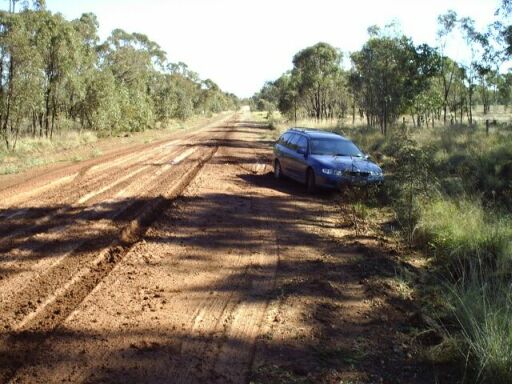
Shellytop Road in August 2010.
This 2WD car could not find ground firm enough for traction and became bogged.
SBRC Fails to Act
The junction of Shellytop Road and McLean Road is
just over a kilometre from the Chinchilla-Wondai Road and is
not far from where the car in the above photo became bogged.
In August 2010 SBRC was advised in writing that
the section of Shellytop Road between the Chinchilla-Wondai Road and McLean Road
"ought to have the highest priority for upgrade to bitumen".
SBRC ignored the advice.
On 20th September 2011 in very dry conditions, a 4WD wagon
carrying local residents rolled over in a single-vehicle accident
at the junction of Shellytop Road and McLean Road (see photo below).
The passengers included small children.
A helicopter transported the injured to hospital.
It is fortunate that as far as is known there turned out to be no serious injuries.
However, you only need to look at the crushed roof of the vehicle to realise that
it is probably only a matter of time before lives are lost on this section of road
if the road is not improved.
Small children were in this vehicle when it rolled on Shellytop Road in September 2011.
In another accident (see photos below) near the eastern end of Shellytop Road,
on 19th October 2005 a local resident rolled her 4WD wagon
within metres of the culvert mentioned above.
The vehicle rolled over completely, landing back on its wheels
but damaging its roof so much that the vehicle was a writeoff.
The vehicle came to rest among trees.
The driver was very lucky to escape with nothing worse than shock and bruises.
A tree or a branch could easily have broken through a window and impaled her
while the vehicle was rolling.
Even more fortunate was the fact that her young children were not in the vehicle at the time.
The vehicle apparently was not travelling fast,
but the road was very slippery due to persistent drizzle.
According to the driver, the vehicle had started to slide around and it rolled when it got to the side of the road.
Inspection of the tyremarks indicated that the vehicle must have started to aquaplane to one side of the road.
The driver had overcorrected and the vehicle moved to the other side of the road.
Another overcorrection caused the vehicle to now have a substantial sideways component of motion on the slippery surface.
When the wheels hit the small embankment at the edge of the road the vehicle rolled.
Rally driving skills would have been required for the road conditions on that day.
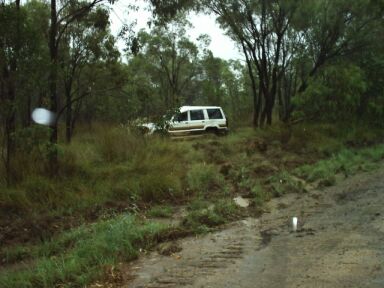
Damaged vehicle after a rollover accident on Shellytop Road in 2005.
Fortunately the rolling vehicle somehow missed the trees.
Tyre marks at the start of the misadventure.
A dangerous culvert is located at the small white posts.
There have been other rollover accidents on the two kilometres of the eastern end of Shellytop Road that are nearest to the Chinchilla-Wondai Road.
Other roads in the area have similar stories.
For example, on 1st July 2011 there was a photograph on the front page of the "South Burnett Times"
of an upsidedown vehicle beside trees, under the headline of "DEATH TRAP".
The story reported in the newspaper was that a resident of Ballogie had been
travelling on Memerambi-Gordonbrook Road in a brand new car
when a large truck had forced the car to the side of the road
where it had flipped and rolled for 50 metres towards trees.
Remarkable Coincidence
By a remarkable coincidence, a person
who may have benefited more than most from the bitumen
at the quiet western end of Shellytop Road appears to be connected to a local councillor.
According to information available on a local website as at March 2012,
Councillor Kathy Duff and a VIP who happens to be one of the owners of
the residence that is the nearest residence to the section of bitumen
at the quiet western end of Shellytop Road
are both named as being local contact persons for a prominent agricultural organisation.
The VIP is a public figure who holds important positions in the world of agribusiness
and is involved in community committees and organisations.
Interestingly, both Councillor Kathy Duff and the VIP
who resides at the bitumen end of Shellytop Road
are also prominent members of a local branch of the LNP political party.
There is evidence that the VIP has political aspirations associated with the LNP.
Also, Councillor Kathy Duff's residence is not far from the residence of the VIP.
The VIP is also a leading player in SBRC's strategic and economic planning offshoot
called "South Burnett Directions".
South Burnett Directions has never been known to kingaroar.com
to have produced any strategic initiatives
that would lead to significant new economic development in the South Burnett.
It's policies tend to be irrelevant.
It's strategic planning abilities appear to be of low quality.
It has never criticised any action or inaction of SBRC.
For example, South Burnett Directions has never taken issue
with any of SBRC's preferential dealings
that undoubtedly constitute a backward impediment
to the economic development of the South Burnett.
Click here
to see a detailed report about South Burnett Directions.
See also
SBRC's Black Strategy 1
for more information about the various ways in which SBRC
gives control of its activities to non-elected cronies.
The bitumen upgrade of the western end of Shellytop Road
was performed some years before Kathy Duff
first became a councillor and therefore she
could not have participated in council decision-making at the time of the upgrade.
It does appear however that a close relative of Councillor Kathy Duff
may have been a councillor of WSC
up until the time that Kathy Duff first became a councillor.
Therefore it must be just a pure coincidence that the property
that appears to have gained most from the bitumen upgrade
several years ago to the quiet western end of Shellytop Road
is owned by people who include a person who appears to be
a local VIP and who appears to be an associate of a local councillor
and who is a leading player in SBRC's South Burnett Directions
and who is active in the LNP.
Road Levy
Update: The Road Levy, and also the Environmental Levy,
were abolished from July 2018 onwards.
It is thought by some that the real reason why SBRC abolished its Road Levy
was to avoid a class action
being organised by a local activist group
to challenge the legality of the levy.
When the Road Levy was introduced in July 2013
it was described by SBRC as being a temporary measure.
In reality it remained in place until 2018
when it was abolished, apparently to dodge a pending legal action.
Mayor Campbell stated in his 2018 budget speech that
"I have been receiving feedback that we have too many special charges
and they should be incorporated into our general rate."
In typical SBRC misinformation style, neither Mayor Campbell
nor any of the local media lackeys have ever mentioned
the legal action that was being prepared.
Considering that the levies are apparently now officially inappropriate,
it is odd that Mayor Campbell failed to explain in his speech
why he had voted for the introduction of the special levies in the first place,
or why for several years
he had repeatedly voted to keep the levies in place.
Here is what kingaroar said about the Road Levy in 2014:-
SBRC's road levy is a substantial fixed charge on every property
even though SBRC claims that
rates are proportional to land valuations.
The $200 per property per year road levy is a preferential subsidy
for the benefit of the holders of large
rural properties who need and make use of the council's roads
far more than townspeople.
The rating system is designed to ensure that wealthy people
with larger and more valuable
properties pay more than people with smaller and less valuable properties.
By imposing a large fixed levy,
SBRC has transferred a substantial part of the the burden of rates
from richer people to poorer people.
Local roads are used mainly by local people and by people visiting local properties.
SBRC has stretched reality even further than it usually does
by in effect claiming that a large agribusiness that may have extensive road frontages
should not have to pay more for local roads than the owner of a small house in town.
Most of the region's extensive network of bitumen rural backroads
are used by very little traffic other than traffic associated
with the people who live there.
If the holders of properties had genuinely to pay for council roads
according to their use of council roads
and according to the road frontages of their properties
then most ratepayers would see a big change in their rates bills,
some much higher, some much lower.
Property owners at the upper caste bitumen end of
Shellytop Road
pay, per metre of road frontage,
less than a tenth of the amount that property owners at the lower caste gravel end of the road pay.
The people who pay the most get the least.
Throughout the South Burnett, there are local bitumen roads with large properties that contribute
very little in road levy compared with some much more densely populated rural gravel roads
that get very little maintenance in exchange for having to pay more than ten times as much.
Boyne River bridge on the Chinchilla-Wondai Road
The bridge over the Boyne River on the Chinchilla-Wondai Road
is the responsibility of Queensland's Department of Main Roads.
It is the responsibility of SBRC to advise the department
about what priorities should be given to the maintenance
of main roads in the region.
There are many main roads in the South Burnett region that are substandard in various respects.
Perhaps the most dangerous example is the bridge over the Boyne River five kilometres east of Durong
on the Chinchilla-Wondai Road.
The narrowness of the bridge means that it is one lane only.
Vehicles coming from the east must give way to vehicles coming from the west.
However, the road at both ends of the bridge slopes steeply down towards the bridge
which makes it relatively difficult for heavy vehicles to stop in time,
particularly if travelling at high speed as sometimes happens.
This bridge has been the scene of many traffic incidents over the years.
However, the bridge over the Boyne River never gets the upgrade it needs to make it safe.



